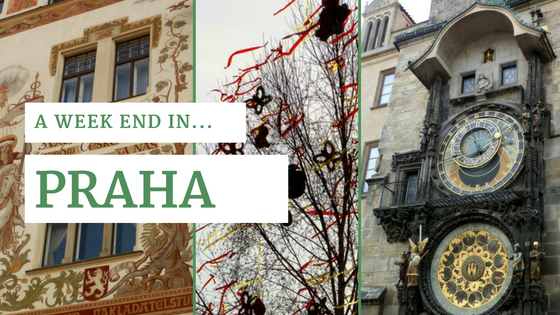A week end in Prague

Hi dear Steemers!
Today I take you with me to the beautiful Prague (Praha in Czech), capital of Czech Republic! Prague is a perfect place for a Week End if you are in Europe. It is pretty much in the centre of Europe, so it is not far to get there from any European cities.
The historic centre is very pretty and it is like an open air museum.
You can see many magnificent churches and cathedral from different ages, visit the Jewish Quarter with emotion, discover the Art Nouveau ... Otherwise try a goulash or of course enjoy nice beers for very good price.


Here is the impressive astronomical clock of Prague, a symbol. It was built by Nicolas de Kadau ( Mikuláš z Kadaně )in the early 15th Century. It is located on the Old Town Square and every hour the crowd gather to watch it. Why? Because the clock is animated. The different characters represented start to move, like the 12 apostles appearing , a skeleton pulling a rope, an angel with a sword.
The clock has got two faces, one indicates the time in many different ways, the one at the bottom is a calendar.

Josefov is the name of the old Jewish Quarter. It comes from Joseph II who wrote a treaty of tolerance in 1781. The first Jews arrived around the 10th century in Prague and have been persecuted several times. Those persecutions are called pogroms.
It is worth a visit to learn about the Jews' history in Prague as it was one of the biggest Jewish community in Europe. You can visit the old cemetery, six synagogues and a museum.


I would definitely advice a visit of St Nicolas church in Mala Strana Quarter. It is on the other side of the Vltava, the river that goes through Prague. This church is a wonderful example of baroque art. It's full of gilt, marble imitations (called stucco), monumental curves and beautiful frescos. We can even say the decoration is overloaded. The baroque style is very expressive. It appeared in the 17th century in Italy and spread all over Europe. This style was a way for the Catholic Church to express itself in opposition to the austerity of the Protestant Church after the Reformation.

To cross the Vltava, walk on Charles Bridge and admire the thirty statues displayed. The most ancient is John of Nepomuk (picture above). The story tells that he was a priest and preacher in Prague, not very popular to the King Venceslas as he was preaching against the Court's disorders. The Queen used to confess to him and the jealous King wanted to know what she was telling to John of Nepomuk. The virtuous man never ever said anything, and the King ordered to tortured him in return. The Queen helped to free him but one day as he was crossing the bridge, the King asked someone to push him into the river. John of Nepomuk died and later on has been made a martyr. Apparently, it gives luck to touch the bottom part of the statue.

That is the frontage of the Hotel Central of Prague, typically Art Nouveau. It is an art of the beginning of the 20th Century and the Hotel Central construction started in 1899. As it is traditionally, they used plaster and stucco as well as pastel colours. The leaves, floral elements and trees representations define this style. Other characteristics would be the use of ironwork, and also glass for furnitures.
If you are interested by this art, Alfons Mucha (pronounce muka) is a main figure in Prague linked to Art Nouveau. To know more about this iconic illustrator visit the Mucha Museum.

That is the gothic Church of Our Lady before Tyn and the Jan Hus memorial, on the Old Town Square. This square is situated on the historic heart of the city.
A word about Jan Hus as he is an icon in Czech Republic. He is a symbol of struggle against the catholic oppression. He was preaching for a return to a pure practice of religion in a time the Catholic Church abused of its power. His main fight was against the Indulgence, a practice that allow the absolution of sins by the Church in exchange of a payment. The funds were used by the Church to built churches, but one knows some money was employ for personal uses by some priest, cardinals or popes.
Jan Hus was declared heretic and they finally burnt him alive on a stake.
If you go to Prague, you will discover a bunch of other weird but fascinating stories link to each monuments.
Let a comment if you enjoyed this article ;)
Cheers and click there to follow me:
@isa-za